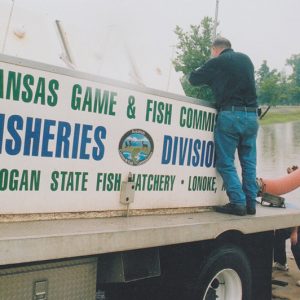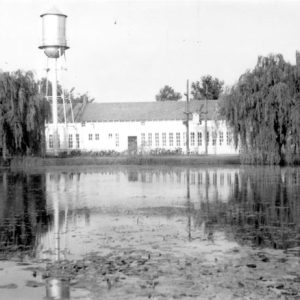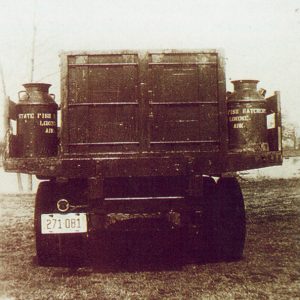calsfoundation@cals.org
Arkansas Game and Fish Commission State Fish Hatcheries
The Arkansas Game and Fish Commission State Fish Hatcheries were built between 1928 and 1940 for spawning and culturing game fish to manage fish populations in natural lakes, rivers, and streams and for stocking lakes built by the U.S. Army Corps of Engineers and the Arkansas Game and Fish Commission. A surge of lake construction began in 1944 with the Corps’ Norfork Lake project in Baxter County, followed by the Game and Fish Commission’s 6,700-acre Lake Conway in Faulkner County. More than thirty Game and Fish Commission lakes were constructed in the next forty years.
The Arkansas Game and Fish Commission now operates four warm-water fish hatcheries, and one cold-water hatchery, which produce millions of fish each year for stocking in public waters. The goals of the fish hatcheries are to produce the appropriate fish species and numbers to assist in establishing, maintaining, or enhancing existing fish populations and to provide the angling public a better fishing opportunity in Arkansas lakes and streams. The public fishing waters in Arkansas are divided into eleven districts in which biologists, for their respective districts, conduct surveys of the fish population to determine which species and how many are needed to best manage the lake or stream. The fish grown at state hatcheries are stocked to maintain a balanced fish population and to supplement fish stocks in heavily fished waters. Fish produced at the hatcheries are especially needed when new lakes are built to start the lake off with the desired fish species and the correct numbers for a balanced fish population. The warm-water hatcheries use earthen ponds for fish production, in which the water fluctuates with the seasonal temperatures. The cold-water hatchery utilizes cold, spring-fed water that stays in the 54 to 64 degree Fahrenheit range throughout the year.
The hatcheries are open to the public from 8:00 a.m. 4:00 p.m., Monday through Friday.
In addition to the five fish hatcheries, the commission also has fish culture facilities in net pens on Lake Ouachita and Bull Shoals Lake and rear fish in cages on Lake Wilhelmina. Catfish are provided to these net pens, and cages from the four warm-water hatcheries during the warmer months as well as trout are provided by the Jim Hinkle State Fish Hatchery and the Norfork and Greers Ferry National fish hatcheries during the cooler months. The net pen facilities are not open to the public. The fish reared in the cage and net pen facilities are used to stock area lakes and rivers.
Joe Hogan State Fish Hatchery
Lonoke (Lonoke County)
In 1928, the Arkansas Game and Fish Commission purchased 267 acres of farmland for the construction of the Lonoke Fish Hatchery from rice farmers Ed Willman, William Pressley Fletcher Jr., and Neil Fletcher for the price of $18,000. The hatchery is located on the Grand Prairie of Arkansas. The clay soils and shallow water table made it ideal for the construction of fish-rearing ponds. Sixteen acres of ponds were built the first year, and the first crop of fish was produced in 1929. The hatchery expanded in the 1940s and again in the 1950s to its current size of 267 acres in fifty-six ponds. In 1956, the hatchery was renamed the Joe Hogan State Fish Hatchery after the first manager of the hatchery, who served the commission from 1928 to 1956. The water source for the hatchery is four deep wells. The hatchery produces largemouth bass (Micropterus salmoides salmoides), bluegill sunfish (Lepomis macrochirus), redear sunfish (Lepomis auritus), black crappie (Pomoxis nigromaculantus), white crappie (Pomoxis annularis), channel catfish (Ictalurus punctatus), blue catfish (Ictalurus furcatus), flathead catfish (Pylodictis olivaris), and white amur (Ctenopharyngodon idella).
The Joe Hogan Hatchery employs eleven individuals for operation of the hatchery and fish culture work.
Andrew H. Hulsey State Fish Hatchery
Hot Springs (Garland County)
Harvey Couch, former president of Arkansas Power and Light (AP&L) and advocate of rural electricity, donated 135 acres of woodland on the south shore of Lake Hamilton for the development of a hatchery. The land was handed over to the commission in 1939, and clearing of the forested land began the same year by members of the Civilian Conservation Corps (CCC) and commission employees. The hatchery, located on the south side of Lake Hamilton in the picturesque Ouachita Mountains, was initially called the Lake Hamilton Fish Hatchery. In 1987, the hatchery was renamed the Andrew H. Hulsey State Fish Hatchery in honor of former commission director Andrew Howard Hulsey. Construction of the hatchery ponds and facilities began in 1940, and more ponds were added in the 1950s. Today, it totals forty-two ponds, of which ninety acres are devoted to fish production. Its water source is Lake Hamilton, and it produces Florida largemouth bass (Micropterus salmoides floridanus), hybrid striped bass (Morone saxatilis X Morone chrysops), striped bass (Morone saxatilis), smallmouth bass (Micropterus dolomieui), walleye (Stizostedion vitreum), bluegill sunfish, grass carp, and blue catfish.
The Andrew H. Hulsey Hatchery employs six employees for the operation of the hatchery and fish culture work.
C. B. “Charlie” Craig State Fish Hatchery
Centerton (Benton County)
The initial land purchase for the Centerton Fish Hatchery in Benton County was made in 1938 by local individuals who were concerned about the conservation of the fish resources in that area of the state. A fundraising campaign to make the land purchase was led by Charlie Craig of Bentonville (Benton County). Craig was a Bentonville native and insurance agent who had a passion for fishing. In 1937, the owner of the spring and acreage around it, Lucius Lay, died; his widow told Craig that she would sell the spring, forty acres, and a house to the commission for $1,800. The commission had no money but wanted a hatchery in northwest Arkansas. Craig raised the money by taking many two-dollar donations. The hatchery was renamed the C. B. “Charlie” Craig State Fish Hatchery in 1997 to honor his efforts in conservation. The commission now owns 141 acres of land, fifty-eight acres of which are in fish production. The hatchery uses a large spring and one deep well for its water source. The Charlie Craig Hatchery produces channel catfish, blue catfish, black crappie, white crappie, bluegill sunfish, walleye, smallmouth bass, and largemouth bass.
The Charlie Craig Hatchery employs five employees for operation of the hatchery and fish culture work.
William H. Donham State Fish Hatchery
Corning (Clay County)
The U.S. Fish and Wildlife Service built the Corning Federal Fish Hatchery in the Mississippi River Delta region of northeastern Arkansas in 1938. The shallow water table and gumbo clay soils of the area made an ideal location for a fish hatchery. Because of budget constraints, the department closed the hatchery in 1983. The Arkansas Game and Fish Commission negotiated with the Fish and Wildlife Service and took control of the hatchery the same year. In 1984, the hatchery was renamed the William H. Donham State Fish Hatchery in honor of William H. Donham, who was legal counsel for the commission from 1973 to 1983. The hatchery sits on 140 acres of land, forty acres of which hold ponds for fish production. Its water comes from wells, and it produces largemouth bass, striped bass, hybrid striped bass, bluegill sunfish, redear sunfish, black crappie, channel catfish, walleye, sauger (Stizostedion canadense), and saugeye (Stizostedion vitreum X Stizostedion canadense).
The hatchery ponds were completely renovated and the facilities modernized in 2006 and 2007. The William H. Donham Hatchery employs four employees for operation of the hatchery and fish culture work.
Jim Hinkle Spring River State Fish Hatchery
Mammoth Spring (Fulton County)
The Jim Hinkle Spring River State Fish Hatchery is the commission’s only coldwater hatchery. It rests on a seven-acre island on the Spring River just below Dam 3. In 1974, a company named Marine Protein built the hatchery for the purpose of making rainbow trout available for table market. The Kroger Company later bought the hatchery, briefly operated it, and then—after deciding that it did not meet their marketing strategy—donated it to the Game and Fish Commission in 1985. The Spring River Hatchery was renovated and expanded in 2003 and now is one of the largest trout hatcheries in the Southeast. Its production facilities include twenty-one raceways and forty-seven in-ground silos. The raceways are concrete vats that are sixty to eighty feet long and eight feet wide. The water enters the upper end of the system and flows out the lower end. The trout are prevented from escaping by a mesh screen covering the outflow. The silos are cylindrical concrete structures placed below ground level that are seventeen feet wide and thirteen feet deep, with a volume of approximately 22,000 gallons. Water flows in at the bottom of the silo through a control valve at a rate of approximately 1,300 gallons of water per minute and spills over the top. A mesh screen is placed around the top of the silo to prevent the trout from escaping.
In 2004, the facility was renamed the Jim Hinkle Spring River State Fish Hatchery in honor of Jim Hinkle, a former Game and Fish commissioner. Trout produced at the hatchery are needed for a “put and take” fishery since there is very little natural reproduction of the species, but the sport of trout fishing attracts approximately 165,000 anglers a year.
Trout, being a cold-water species, are stocked in river waters below dams that were created for hydroelectric power. The deep water in the lake below the thermocline creates cold water in the layer called the hypolimnion. The water coming through gates and turbines at the bottom of the dam is too cold for many warm-water fish species to thrive in; therefore, trout are stocked as mitigation for the loss of habitat and displacement of the warm-water fishes.
The Jim Hinkle Hatchery produces rainbow (Oncorhynchus mykiss) and cutthroat trout (Oncorhynchus clarki). It employs eight employees for the operation of the hatchery and fish culture work.
For additional information:
Arkansas Game and Fish Commission. Arkansas Wildlife: A History. Edited by Keith Sutton. Fayetteville: University of Arkansas Press, 1998.
Arkansas Game and Fish Commission. http://www.agfc.com (accessed August 19, 2023).
Arkansas Wildlife. Little Rock: Arkansas Game and Fish Commission (1969–).
Berry Beavers
Arkansas Game and Fish Commission
 Fingerling Stocking
Fingerling Stocking  Joe Hogan Fish Hatchery
Joe Hogan Fish Hatchery  Joe Hogan Fish Hatchery
Joe Hogan Fish Hatchery  Joe Hogan Fish Hatchery Truck
Joe Hogan Fish Hatchery Truck 




Comments
No comments on this entry yet.